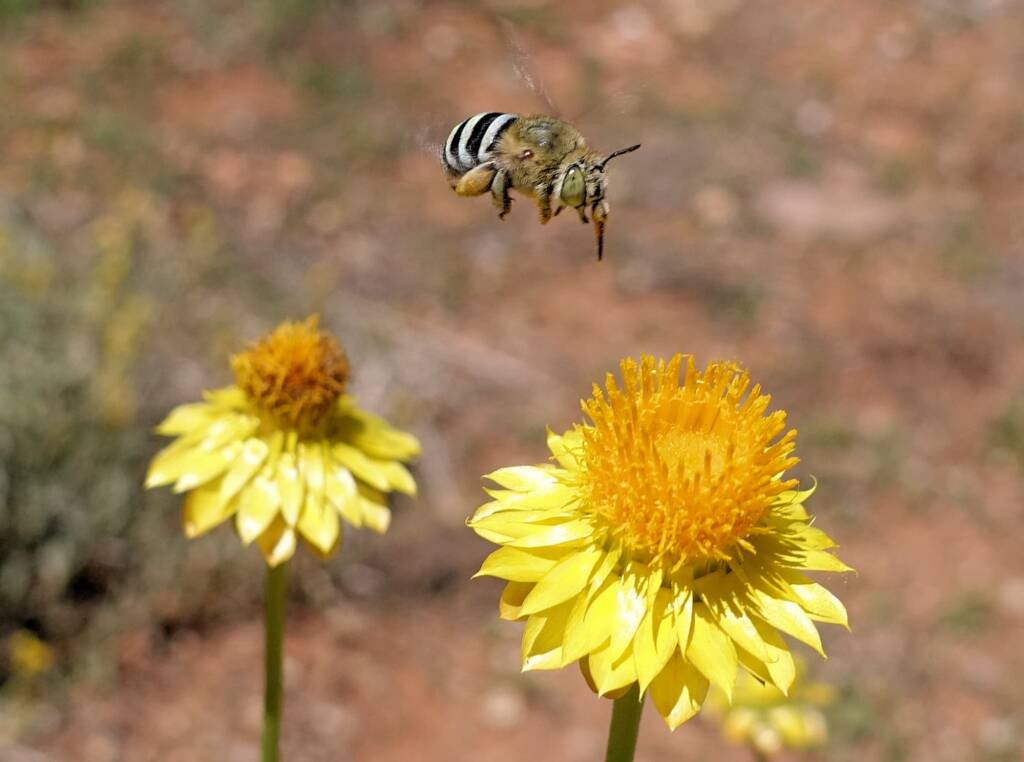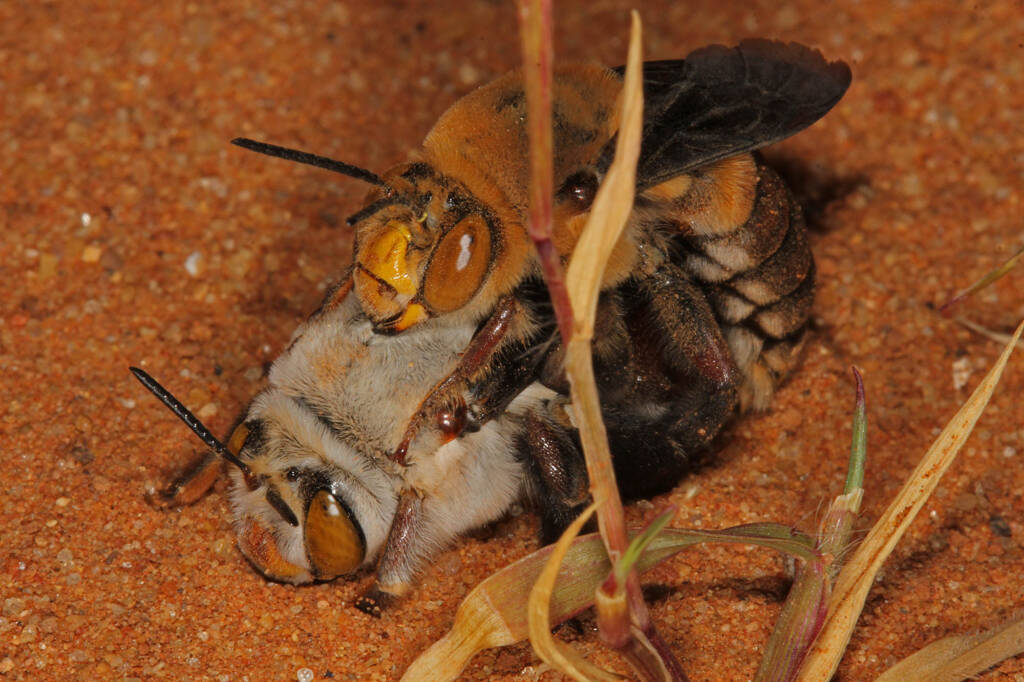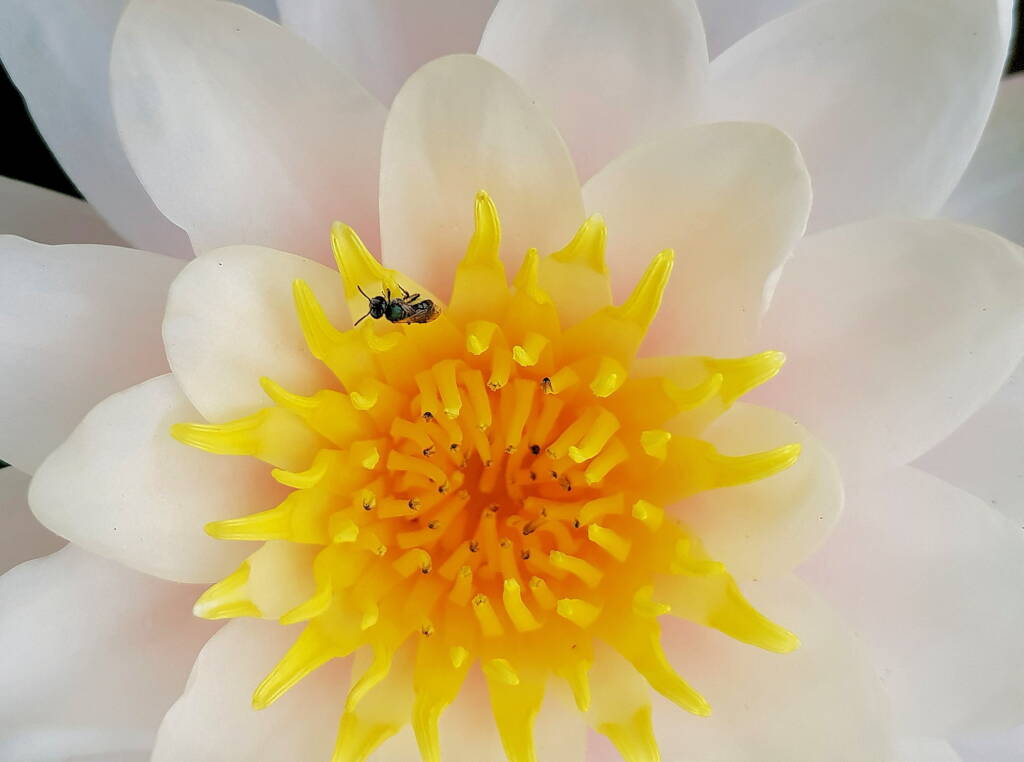BeesBees Anatomy Bee Behaviour Blogging Bees… Bees – image index Amegilla Bee Apis mellifera Austroplebeia australis Austrothurgus Braunsapis sp Ceylalictus perditellus Colletidae Euryglossinae Exoneura Homalictus Hyleoides bivulnerata Lasioglossum Lasioglossum (Chilalictus) Lipotriches Megachile Meroglossa Stenotritidae Tetragonula Thyreus Xylocopa
Bees belong to the Order Hymenoptera, that includes wasps, ants and sawflies, within Suborder Apocrita and Superfamily Apoidea. They are presently considered a clade, called Anthophila. There is considered to be over 20,000 bee species worldwide, living on every continent except Antarctica. They live in a range of ecosystems from forest, grasslands and arid desert regions.

In Australia there are four main bee families: Apidae, Colletidae, Halictidae and Megachilidae. There is thought to be some 2,000 species of native bees in Australia.1 Collectively many of these bees are called bush bees, native bees, native bush bees, and stingless bees, and some specific genus and species having their own common name, such as the Golden-browed Resin Bee and the Masked Bee. Whilst the majority of species of Australian native bees do sting, there are approximately 11 species that do not sting.
An ABC story (1 October 2021) reported that Australia has around 1,650 species of native bees that we know of, with up to 2,500 species in Australia. There is considered to be over 20,000 bee species worldwide, with iNaturalistAU reporting (from Wikipedia) that there are over 16,000 known species of bees in seven recognized biological families (currently considered a clade, called Anthophila).
Source: See Footnote & References 2 and 3

Bush Bee and Native Bee
Of the Australian native bees, very few produce honey stores that of any useful amount for humans. Of those that do, they are the social stingless or sugarbag bees, Austroplebeia and Tetragonula species, that are found in northern and eastern Australia. These same bees build nests from a secreted wax mixed with resin, and were commonly and traditionally used by Aboriginal people for their honey and their wax.
More importantly, the native bees provide an invaluable pollination service, that are important not only for local flora, but also for many of our crop plants.

The most recognised and cultivated bee is the Western Honey Bee, also known as the European Honey Bee, used in the production of honey.

Solitary Bee
Solitary bees consist of about 75% to 90% of species, among which include the mason bees, carpenter bees, leafcutters bees, and sweat bees. The rest of the species of bees live socially in colonies and include the honey bees, bumblebees and stingless bees.

Bees vary in size and actually come in a variety of colours, including, red, blue, green, yellow, black and white. Some species have stripes and others have a metallic sheen.


With the growing interest in the many bee species, there is a lot more information available in publications and online. Further support can be found in a number of Facebook groups, online resources such as Atlas of Living Australia and iNaturalistAU, and local naturalist clubs.

You can check out some of the great blogs by Gary Taylor, whose passion among many things includes the native bees:
- Hylaeus mysterium puella…
- Sweat running down my face…
- How long do native bees live for
- The unmistakable eyes of Megachile aurifrons
- The “buzz pollination” club
- Beauty is in the eye of the bee holder
- The Art of a “Resin Bee”
- alone in her last few moments to ponder such a short existence
- Lesser noticed (but often more exquisite) little native bees
- Peek-a-boo…
- To bubble or not to bubble…
- The bee most likely to fall out of bed…
- Ruby… bubbling
- Dunno what her chances are…

You can also check out some of the great blogs and contribution by Marc Newman, whose passion among many things includes the native bees:
- Will you still love me, when I lose my looks…
- Living dangerously…
- What’s the buzz…
- Looking for Love…
- Too much for Mrs Carpenter Bee
- Scientific classification
- Kingdom: Animalia
- Phylum: Arthropoda
- Class: Insecta
- Order: Hymenoptera
- (unranked): Unicalcarida
- Suborder: Apocrita
- Superfamily: Apoidea
- Clade: Anthophila
- Families:
- Andrenidae
- Apidae
- Colletidae
- Halictidae
- Megachilidae
- Melittidae
- Stenotritidae
- Synonyms: Apiformes

Footnote & References
- Can you beelieve?! Our guide to native bees, by Eliza Keckm, 30 Aug 2018, CSIROscope, https://blog.csiro.au/can-you-beelieve-our-guide-to-native-bees/
- Australian native bees eligible for IUCN Red List of threatened species in the aftermath of Black Summer bushfires, ABC News, 1 October 2021, https://www.abc.net.au/news/science/2021-10-01/australias-native-bees-black-summer-bushfires/100503694
- Bees (Epifamily Anthophila), iNaturalistAU, https://inaturalist.ala.org.au/taxa/630955-Anthophila
- Bee Aware of Your Native Bees (Australia), Facebook group, https://www.facebook.com/groups/1493769094196721
- Which native bees are in your area?, Aussie Bee, https://www.aussiebee.com.au/beesinyourarea.html
- Hymenoptera, https://en.wikipedia.org/wiki/Hymenoptera (last visited Dec. 7, 2021)
- Bees: Suborder Apocrita, Author David Britton, Australian Museum, https://australian.museum/learn/animals/insects/bees-suborder-apocrita/
- The Bee Hotel ID Guide, Written by Megan Halcroft and Michael Batley, University of Westen Sydney, https://www.beesbusiness.com.au/articles/Halcroft_and_Batley_The_Bee_Hotel_ID_Guide.pdf
- Bee, https://en.wikipedia.org/wiki/Bee (last visited Dec. 7, 2021)
- Bees, The National Wildlife Federation, https://www.nwf.org/Educational-Resources/Wildlife-Guide/Invertebrates/Bees
- How to make a native bee hotel, Words and images by Kit Prendergast (BSc, PhD researcher at Curtin University), About The Garden Pty Ltd, https://www.aboutthegarden.com.au/how-to-make-a-native-bee-hotel/
- What do bees look like?, Australian Museum, https://australian.museum/learn/species-identification/ask-an-expert/what-do-bees-look-like/
- Protect and Enjoy the 1,700 Species of Australian Native Bees…, Aussie Bee, https://www.aussiebee.com.au/
- A Guide to Native Bees of Australia, by Dr Terry Houston, CSIRO Publishing, ISBN 978-1-4863-0406-6
- A photographic guide to Australia’s bees, by Australian Geographic, photographer James Dorey, 20 June 2017, https://www.australiangeographic.com.au/topics/wildlife/2017/06/the-secret-life-of-bees/
- Bees of Australia, A Photographic Exploration, by James Dorey, CSIRO Publishing, ISBN: 9781486308491
- Bees of Australia: up close with native species – in pictures, The Guardian, https://www.theguardian.com/environment/gallery/2018/oct/29/bees-of-australia-up-close-with-native-species-in-pictures
- Native Bees ACT, Native bees of the ACT and NSW South Coast, A spotter’s guide by Peter Abbott, https://nativebeesact.net/
- The Australian bee genera, An annotated, user-friendly key, by Tobias J. Smith, University of New England, https://www.beeawarekids.com.au/the-australian-bee-genera.html
- Powerful Pollinators, Encouraging insect pollinators in farm and garden landscapes, Wheen Bee Foundation, https://www.wheenbeefoundation.org.au/our-work/projects/powerful-pollinators/
BeesBees Anatomy Bees Antenna It’s in the eyes Pre-pygidial fimbria Wings of the bee Bee Behaviour Bubbling Bees Buzz Pollination Operculum lifting behaviour Blogging Bees… Bees – image index Amegilla Bee Apical tergites of females Amegilla Amegilla Bee Body Colour Amegilla adelaidae Amegilla aeruginosa Amegilla asserta Amegilla chlorocyanea Amegilla walkeri Teddy Bear Bees (Asaropoda) Apis mellifera Dark Apis mellifera Apis mellifera — Captured flora moments Austroplebeia australis Austrothurgus Austrothurgus rubricatus Braunsapis sp Ceylalictus perditellus Colletidae Amphylaeus obscuriceps Hylaeus spp – Masked Bee Callomelitta antipodes Leioproctus Neopasiphae mirabilis Paracolletes crassipes Paracolletes nigrocinctus Trichocolletes Euryglossinae Euryglossinae Index Callohesma Dasyhesma Euhesma Eurglossa adelaidae Euryglossa calaina Euryglossa ephippiata Euryglossina fuscescens Xanthesma Exoneura Homalictus Homalictus dotatus Homalictus urbanus Hyleoides bivulnerata Lasioglossum Lasioglossum (Australictus) peraustrale Lasioglossum (Chilalictus) lanarium Lasioglossum (Chilalictus) brunnesetum Lasioglossum (Chilalictus) willsi Lasioglossum (Chilalictus) Lipotriches Lipotriches australica Lipotriches gracilipes Lipotriches flavoviridis Lipotriches muscosa Lipotriches phanerura Megachile Megachile aurifrons Megachile erythropyga Megachile (Eutricharaea) Megachile (Hackeriapis) canifrons Megachile (Hackeriapis) rhodura Megachile punctata Megachile (Rhodomegachile) deanii Megachile semiluctuosa Megachile (Thaumatosoma) Megachile ustulata Meroglossa Meroglossa impressifrons Meroglossa rubricata Stenotritidae Ctenocolletes albomarginatus Ctenocolletes nicholsoni Ctenocolletes rufescens Tetragonula Tetragonula carbonaria Thyreus Thyreus caeruleopunctatus Thyreus waroonensis Xylocopa Xylocopa aerata Xylocopa bombylans

